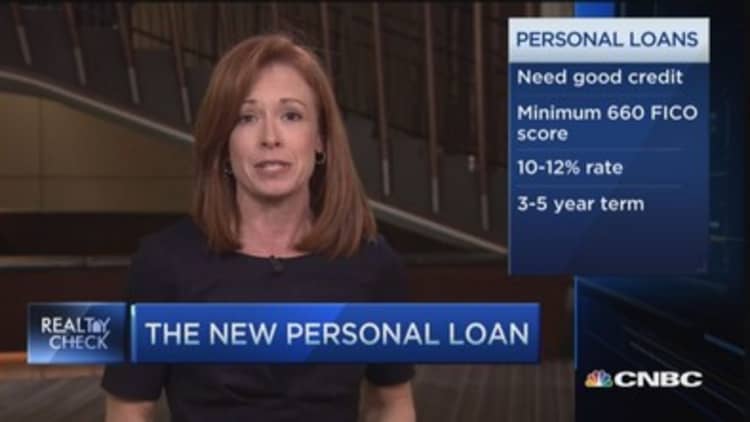
Like many others, Nik Doner, 33, struggled with growing credit card debt and interest charges of up to 30 percent.
"I was going paycheck to paycheck, and I thought credit cards were my only option," said Doner, who is single and lives in Seattle.
Instead, Doner, a video producer and an actor, secured a personal loan to pay down his $5,000 credit card tab and start a savings account. He is now paying off that three-year loan at 9.6 percent.
For those with little to no savings like Doner, rainy days are about borrowing money.
And apparently, there have been plenty of those. The number of people taking out unsecured loans jumped close to 30 percent in recent years, to 13.72 million in 2015 from 10.57 million in 2013, according to the latest data available from TransUnion.
Another 24 million Americans are likely to take out a personal loan this year alone, according to a separate report by Bankrate.
"The personal loans market is hot right now," according to Bankrate's personal loans expert Todd Albery.
"It reflects the good state of the economy," explained Jason Laky, a senior vice president at TransUnion. "Consumers are feeling the benefits of four to five years of solid economic growth and strong gains in employment. And as that happens, they are willing to take out loans again."
Personal loans, or unsecured loans, often act as the placeholder for those with a big upcoming expense but little in the way of savings. They do not require borrowing against something of value, such as a house or car, which makes them particularly attractive for those without that kind of equity. However, that generally means the loans are available at a slightly higher interest rate than a home equity loan.
Personal loans are also locked in over shorter terms, like one to five years, and payments are auto-deducted from a checking account, which decreases the odds of missing a payment or defaulting.
"From a financial responsibility standpoint, it feels like a semi-savvy way to take on debt," said Bankrate's Albery.
Personal loans are well suited for smaller loan amounts than a typical home equity loan, but more than one would want to run up on credit cards — generally, anything up to $35,000, Albery said.
Before the Great Recession and the historic housing crash, homeowners used their homes to access as much cash as the bank would allow. But borrowers who were burned by falling housing prices, not to mention today's tighter lending standards, are considerably more wary now when it comes to home equity loans and lines of credit.
"The decline in home values and home lending left consumers with this option," noted Laky, referring to the rise of unsecured personal loans.
A slew of online lenders, like Lending Club and Prosper, have emerged in recent years to offer these types of loans as the alternative, particularly for millennials that may want to consolidate their debt but don't have the home equity for a secured loan to do it.
In the meantime, the average loan balance on unsecured loans has been creeping higher. In 2015, the average balance was $7,235, up more than 7 percent from the year earlier, according to TransUnion.
The average balance will grow by another 5 percent in 2016, to $7,599, according to TransUnion's personal loan forecast.
The interest rate on a personal loan is 11.3 percent, on average, according to Bankrate, although those with very good credit can get a rate as low as 5.5 percent. That's notably less than the average credit card rate of 15.7 percent.
But despite their current popularity, this type of loan is not for everyone, Albery cautioned.
People with home equity should consider home equity loans and lines of credit, which charge lower rates and have a tax advantage, he explained. Those without that kind of collateral but with good or excellent credit could qualify for a zero percent balance transfer credit card for as long as 21 months, Albery added.




